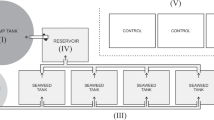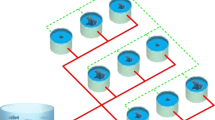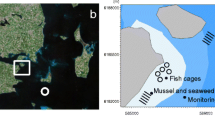Abstract
The tetrasporophyte of Asparagopsis armata has been previously established as a novel seaweed biofilter for integrated land-based mariculture. The species growth and biofiltration rates were much higher than the values described in the literature for Ulva spp., the most common seaweed biofilter. However, a validation of the advantage of one species over the other requires a study of the performances of these two species in the same system at the same time. In this work, we compared the biofiltration performance and biomass yield of A. armata and Ulva rigida cultivated in the effluents of a fish farm in southern Portugal. Comparisons were performed at different water renewal rates and in two seasons of the year. The maximum total ammonia nitrogen (TAN) removal rates were similar for both species in December (2.7 and 2.8 g TAN m–2 day–1 for U. rigida and A. armata, respectively) and higher for A. armata (6.5 g TAN m–2 day–1) than for U. rigida (5.1 g TAN m–2 day–1) in May. Higher differences were observed when estimating the nitrogen biofiltration through the organic nitrogen yield (N yield) of the biomass produced, particularly in May. This estimate is directly related with the biomass yield and the N content in the tissue which were always higher for A. armata than for U. rigida. In December, the maximum biomass yields were 71 g dry weight (DW) m–2 day–1 for A. armata and 44 g DW m–2 day–1 for U. rigida, while in May, the yield of A. armata was 125 g DW m–2 day–1 and of U. rigida was 73 g DW m–2 day–1. This study confirmed that A. armata is indeed a more efficient biofilter than U. rigida. To the best of our knowledge, the production rates reported here are the highest ever reported for macroalgae cultivated in tanks.


Similar content being viewed by others
References
Beer S (1994) Mechanisms of inorganic carbon acquisition in marine macroalgae (with special reference to the Chlorophyta). Prog Phycol Res 10:179–207
Bidwell RG, McLachlan J, Lloyd ND (1985) Tank cultivation of Irish oss, Chondrus crispus Stackh. Bot Mar 28:87–97
Bolton JJ, Robertson-Andersson DV, Shuuluka D, Kandjengo L (2009) Growing Ulva (Chlorophyta) in integrated systems as a commercial crop for abalone feed in South Africa: a SWOT analysis. J Appl Phycol 21:575–583
Chisti Y (2007) Biodiesel from microalgae. Biotechnol Adv 25:294–306
Chopin T, Buschmann A, Halling C, Troell M, Kautsky N, Neori A, Kraemer GP, Zertuche-González J, Yarish C, Neefus C (2001) Integrating seaweeds into marine aquaculture systems: a key toward sustainability. J Phycol 37:975–986
Cohen I, Neori A (1991) Ulva lactuca biofilters for marine fishpond effluents. I. Ammonia uptake kinetics and nitrogen content. Bot Mar 34:475–482
De Busk TA, Blakeslee M, Ryther JH (1986) Studies on outdoor cultivation of Ulva lactuca L. Bot Mar 29:381–386
Grasshoff K, Ehrhardt M, Kremling K (1983) Methods of seawater analysis, 2nd edn. Verlag Chemie, Weinheim, 419 pp
Grobbelaar JU, Nedbal L, Tichy V (1996) Influence of high frequency light/dark fluctuations on photosynthetic characteristics of microalgae photoacclimated to different light intensities and implications for mass algal cultivation. J Appl Phycol 8:335–343
Jimenez del Rio M, Ramazanov Z, Garcia-Reina G (1994) Optimization of yield and biofiltering efficiencies of Ulva rigida C. Ag. cultivated with Sparus aurata L. waste waters. Sci Mar 58:329–335
Jimenez del Rio M, Ramazanov Z, Garcia-Reina G (1996) Ulva rigida (Ulvales, Chlorophyta) tank culture as biofilters for dissolved inorganic nitrogen from fishpond effluents. Hydrobiologia 326(327):61–66
Lahaye M, Robic A (2007) Structure and functional properties of Ulvan, a polysaccharide from green seaweeds. Biomacromolecules 8:1764–1774
Langton RW, Haines KC, Lyon RE (1977) Ammonia-nitrogen production by the bivalve mollusc Tapes japonica and its recovery by the red seaweed Hypnea musciformis in a tropical mariculture system. Helgol Mar Res 30:217–229
Mata L, Santos R (2003) Cultivation of Ulva rigida (Ulvales, Chlorophyta) in raceways, using semi-intensive fishpond effluents: yield and biofiltration. In: Chapman AR, Anderson RJ, Vreeland VJ, Davison IR (eds) Proceedings of the 17th International Seaweed Symposium, Cape Town 2001. Oxford University Press, Oxford, pp 237–242
Mata L, Silva J, Schuenhoff A, Santos R (2006) The effects of light and temperature on the photosynthesis of the Asparagopsis armata tetrasporophyte (Falkenbergia rufolanosa), cultivated in tanks. Aquaculture 252:12–19
Mata L, Silva J, Schuenhoff A, Santos R (2007) Is the tetrasporophyte of Asparagospis armata (Bonnmeiasoniales) limited by inorganic carbon in integrated aquaculture? J Phycol 43:1252–1258
McConnell O, Fenical W (1977) Halogen chemistry of the red alga Asparagopsis. Phytochemistry 16:367–374
McDonald ME (1987) Biological removal of nutrients from wastewater: an algal-fish system model. In: Reddy KR, Smith WH (eds) Aquatic plants for water resource recover. Magnolia Publishing, Pineville, pp 959–968
Msuya FE, Neori A (2002) Ulva reticulata and Gracilaria crassa: macroalgae that can biofilter effluent from tidal fishponds in Tanzania. Western Indian Ocean J Mar Sci 1:117–126
Neori A, Cohen I, Gordin H (1991) Ulva lactuca biofilters for marine fishpond effluents. II. Growth rate, yield and C:N ratio. Bot Mar 34:483–489
Neori A, Shpigel M, Ben-Ezra D (2000) A sustainable integrated system for culture of fish, seaweed and abalone. Aquaculture 186:279–291
Neori A, Chopin T, Troell M, Buschmann AH, Kraemer GP, Halling C, Shpigel M, Yarish C (2004) Integrated aquaculture: rationale, evolution and state of the art emphasizing seaweed biofiltration in modern mariculture. Aquaculture 231:361–391
Pesando D, Caram B (1984) Screening of marine algae from the French Mediterranean coast for antibacterial and antifungal activity. Bot Mar 27:381–386
Ryther J, Goldman J, Gifford C, Huguenin J, Wing A, Clarner J, Williams L, Lapointe B (1975) Physical models of integrated waste recycling—marine polyculture systems. Aquaculture 5:163–177
Salvador N, Garreta A, Lavelli L, Ribera M (2007) Antimicrobial activity of Iberian macroalgae. Scientia Marina 71(1):101–113
Schuenhoff A, Mata L, Santos R (2006) The tetrasporophyte of Asparagopsis armata as a novel seaweed biofilter. Aquaculture 252:3–11
Troell M, Halling C, Neori A, Chopin T, Buschmann AH, Kautsky N, Yarish C (2003) Integrated mariculture: asking the right questions. Aquaculture 226:69–90
Acknowledgments
This research was financed by EU project QLRT-1999-31334 (SEAPURA) and by the project POCI⁄MAR⁄59659⁄2004 from the Fundação para a Ciência e Tecnologia, Portugal. Leonardo Mata and Andreas Schuenhoff were further financed by the Portuguese FCT PhD-scholarships (SFRH/BD/12647/2003 and SFRH/BD/13645/2003, respectively). We would like to express our deepest gratitude to Dr. Jorge Santinha, manager of Aquamarim, for all the support related to our research on integrated aquaculture and to all people involved in the field work: Diane Cunha, Bruno Lasserre, Charles Pontonnier, and Andrey Petryuk.
Author information
Authors and Affiliations
Corresponding author
Rights and permissions
About this article
Cite this article
Mata, L., Schuenhoff, A. & Santos, R. A direct comparison of the performance of the seaweed biofilters, Asparagopsis armata and Ulva rigida . J Appl Phycol 22, 639–644 (2010). https://doi.org/10.1007/s10811-010-9504-z
Received:
Revised:
Accepted:
Published:
Issue Date:
DOI: https://doi.org/10.1007/s10811-010-9504-z




